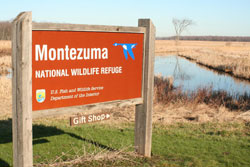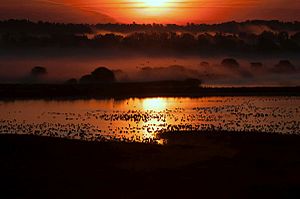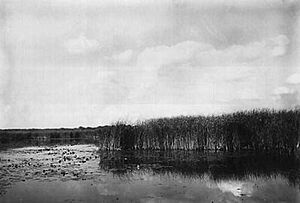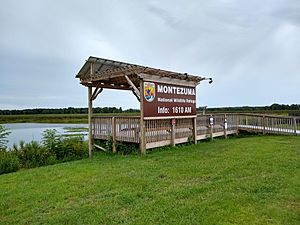Montezuma National Wildlife Refuge facts for kids
Quick facts for kids Montezuma National Wildlife Refuge |
|
|---|---|
|
IUCN Category IV (Habitat/Species Management Area)
|
|
 |
|
| Location | Seneca County, New York |
| Nearest city | Seneca Falls, New York |
| Area | 10,004.58 acres (40.4871 km2) |
| Established | 1937 |
| Governing body | U.S. Fish and Wildlife Service |
| Website | Montezuma National Wildlife Refuge |
| Designated: | May 1973 |
The Montezuma National Wildlife Refuge is a special place for nature. It is a wildlife preserve run by the United States Fish and Wildlife Service. This refuge is part of the Montezuma Swamp, found at the northern end of Cayuga Lake.
The preserve covers about 10,000 acres (40 square kilometers). It has many swamps, water pools, and channels. This makes it a very important stopping point for birds that travel long distances. The refuge is located in New York state, between the cities of Rochester and Syracuse, New York. It includes parts of Seneca, Cayuga, and Wayne counties.
In May 1973, the Montezuma Marshes were named a National Natural Landmark. This means they are a very important natural area. A small part of the site, about 100 acres, is known as one of the best examples of untouched swamp woodlands in New York. The New York Northern Montezuma Wildlife Management Area is next to the refuge. It helps protect even more of the Montezuma Swamp.
This refuge is a key spot along the Atlantic Flyway. This is a major path that many birds use when they migrate. The refuge gives these birds a safe place to rest and find food.
Contents
What Animals Live Here?
The Montezuma National Wildlife Refuge is home to many different animals. It is especially known for its birds.
Birds of the Marsh and Water

Many kinds of birds live in the marsh and water areas. These include:
- Great blue herons, which are tall birds with long legs.
- Green-backed herons, which are smaller and often hide in plants.
- Great egrets, which are large white birds.
- Black-crowned night-herons, which hunt at night.
- Virginia rails and soras, which are shy marsh birds.
- Bitterns, which are masters of camouflage.
- Common moorhens and pied-billed grebes, which swim on the water.
Ducks, Geese, and Eagles
The refuge is a popular place for ducks and geese. You can often see many Canada geese and snow geese here. Other common ducks include black ducks and mallards.
The refuge also has a special area where bald eagles have been nesting. Bald eagles are large birds of prey and a symbol of the United States. It's exciting to see them raising their young here.
Mammals of the Refuge
Besides birds, many mammals also live in the refuge. These animals roam freely through the different habitats. Some of the mammals you might spot include:
- Raccoons, known for their masked faces.
- Coyotes, which are wild dogs.
- Muskrats, small rodents that live in water.
- Squirrels and chipmunks, which are common in the trees.
- Red foxes and gray foxes, which are clever hunters.
- Beavers, known for building dams.
- Various types of bats.
History of Montezuma Marsh
The land where the refuge now sits has a long and interesting history.
How the Land Was Formed
The Finger Lakes Region, including the Montezuma area, was shaped by melting glaciers. This happened over ten thousand years ago. As the glaciers melted, they left behind large lakes. Over time, the northern and southern ends of these lakes slowly turned into big marshes.
Early Inhabitants
The first people known to live in this area were the Algonquin Indians. Later, the Cayugas, who were part of the Iroquois Nation, lived here. They used the rich resources of the marsh for food and shelter.
The name "Montezuma" came from Dr. Peter Clark in 1806. He named his home "Montezuma" after the palace of the Aztec Emperor Montezuma in Mexico City. Eventually, the marsh, a nearby village, and the refuge all took on this name.
Changes from Canals
For a long time, the marsh stayed mostly the same. But in the 1800s, big changes came with the building of the Erie Canal. People realized that smaller canals could connect Seneca Lake and Cayuga Lake to the main Erie Canal. This also brought up the idea of draining the marshes.
Work on the canal system began in 1817. By 1825, boats could travel from Lake Erie all the way to New York City. The Seneca-Cayuga canal started in 1818. By 1828, boats could go from Geneva to the Erie Canal at Montezuma. The Erie Canal itself did not change the marshes much. This was because the Seneca River still flowed directly from Cayuga Lake into the marsh.
Draining the Marshes
More changes happened in 1910. The Seneca and Cayuga extension of the New York State Barge Canal was made wider and rebuilt. A lock was built at the north end of Cayuga Lake. Also, a dam was built at the lake's outlet. These changes lowered the river's water level by about 8 to 10 feet. This caused the water to drain away from the marshes. The winding rivers were also made straight and deeper, which helped drain even more water.
Creating the Refuge
In 1937, the Bureau of Biological Survey bought 6,432 acres (26 square kilometers) of the former marshland. This group later became the US Fish and Wildlife Service. The Civilian Conservation Corps, a group of workers, then began building low walls called dikes. These dikes would hold water and help bring back the marsh habitat that had been lost.
The refuge officially opened in 1938. It was first called the Montezuma Migratory Bird Refuge. President Franklin D. Roosevelt signed an order on September 12, 1938, to create this bird refuge. The main goal was to provide a safe stopping point for waterfowl and other birds that migrate. The refuge helped restore the marshland that was lost when the Cayuga and Seneca Canal was built. This canal connected the Finger Lakes to the Erie Canal.
In May 1973, the Montezuma Marshes were named a National Natural Landmark. This was a big honor for the refuge.
In 2000, a group of musicians called "Harmony With Nature" performed a concert at the refuge. They played music by the late John Denver. This was the first time a musical show was held on federally protected wildlife land.
Visiting the Refuge
The Montezuma National Wildlife Refuge is not just for animals; it's also a great place for people to visit. You can observe wildlife and enjoy nature. The refuge is open every day during daylight hours.
Wildlife Drive
One popular way to see the refuge is by driving the 3.5-mile (5.6 km) Wildlife Drive. This is a one-way auto tour. It gives you many chances to see and photograph wildlife. The main part of the drive is a 1,600-acre (6.5 square kilometer) wetland. This wetland is full of different kinds of waterfowl, waterbirds, and other animals. The drive is open most of the year. However, it might be closed in winter if the road is not safe.
Trails and Visitor Center
If you like to walk, there are two trails available:
- The 2-mile (3.2 km) Esker Brook Trail.
- The 3/4-mile (1.2 km) Oxbow Trail.
There is also a visitor center and gift shop. They are open from April 1 to December 1. At the center, you can find educational brochures, exhibits, and animal specimens. These help you learn more about the refuge and its wildlife.
The New York State Thruway passes through the northern part of the preserve. This means that people driving on the Thruway can get a quick look at the refuge as they pass by.






